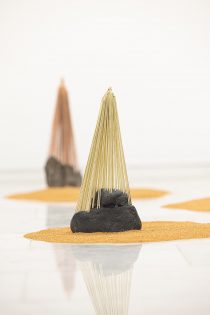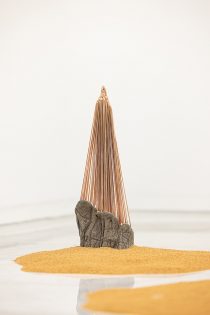Discoverer of the World: Defining the Ambiguous Structure of Vision and Cognition _ Kyoung-Rin Park, 2013
|
Introduction to Park Cheon-Wook’s solo exhibit titled Without Belief Artist Park Cheon-Wook has focused on revealing the flaws of human visual cognition by displaying familiar objects or distorting photographic images. For instance, he wrapped a collection of mundane objects with layers and layers of clear plastic sheets to create an “artistic installation.” Park has also set up a theater with a photographic image of a zebra placed onstage. It only takes one step to realize that the zebra is no photograph but a distorted sculpture. Park’s audience would leave the exhibit in a state of mild shock. Park’s latest exhibit is an extension of the artist’s previous works but takes on a whole new perspective. This time, Park is an adventurer, off to explore the shadowy areas of human cognition. There is an empty space where there is nothing but white. A well-built man leisurely walks into the white space. This is the beginning of Park Cheon-Wook’s short film Without You. Back on film, we find ourselves face to face with the man on screen. The man’s dark skin tone draws stark contrast with the white background, as if the man is drawn on a white canvas. He holds up a brush and begins to paint himself from head to toe. The man continues to paint a transparent screen with white paint to cover himself up. Whereas an artist paints the human body, the model in this short film does the exact opposite. This piece urges the audience to review their subjective perception and view their bodies from an objective perspective. In other words, Without You questions the act of “viewing.” ‘Seeing’ is an activity that requires two principles: the viewer and the viewed. Only then is the act of “seeing” possible. Park Cheon-Wook questions a proposition that we all take for granted. The man in the short film has nothing but his own cognition to rely on when painting over his body. He must remember what his body looked like. The brush strokes are fragments of his cognition, erasing his body from sight. The fleshy gaps are errors in the man’s cognition and a mysterious area that has yet to connect with the man’s conscience. Such is revealed in a specific environment set up by the artist for that purpose. The simple exercise demonstrated in the video draws an answer to Park’s question – human visual cognition is flawed. His short film can be said to question visual arts in general. It is impossible to gain absolute understanding of an object through vision. Thorough understanding entails multi-faceted approach and comparison with other samples. It also involves observation over a long period of time. Another piece from Park’s latest exhibit is Equilibrium Conflict. It is an addition to the artist’s series dubbed Grow in the Middle, which can also be considered a stand-alone piece due to its uniqueness. The piece consists of a video of eight plants growing in different directions and the actual plants. The artist draws a border and captures the moment when an object is caught in between; hence the title “conflict.” The video section of Equilibrium Conflict is in cartoon format based on footage of plants growing over a 100-day period. The timeline does not travel in one straight line; instead, it weaves back and forth, jumping to the past and back. The plants seem to dance to the background sound, growing explosively to the queue of the loud banging noise. The actual plants, overgrown as they are, are placed before the audience’s eyes, reminding the audience that they are in the “present,” and that time cannot exist without space. At another side of the exhibit, one will find the Flag Series, which looks like a collection of colorful abstract paintings from a distance. The artist picked a selection of the most unrecognized flags from over 200 national flags from around the world to recompose it into a symbolic flag. For instance, Black Imagination is a combination of red, black, and star shapes. The audience will find the strange placing and structure of the canvas puzzling and odd. Only when they read the title do they feel as if they have partial understanding of the artist’s intent. Park has put together a clever mechanism to realize how comforting it is to know what one is seeing. Park Cheon-Wook questions visual cognition through his latest exhibit, yet his ultimate objective is to experiment on different ways of fully understanding the inner works of this world. Until now, Park has used structure and sculptures to fool human visual cognition. In this exhibit, Park ventures further into human cognition by journeying into the world of the unseen. He records a man painting over his body to track blank spaces in visual cognition; eight plants visualize the connection between time and space. Finally, the flag series creates a new nation by sewing together parts of the unrecognized world. If understanding the world is life as well as the purpose of art, there are a million different paths you can choose from. When a myriad of objects making up this world appear before us, we must understand that they have not simply existed. Instead, they are an extension of our cognition and an important part of our experience. One thing is for sure though – everything is in the process of completion. They may never be complete, but that does not matter. Park Cheon-Wook collects incomplete fragments of images scattered in our consciousness to create a visual art piece. He is the discoverer of hidden, vague visual cognition. Park chooses to doubt unquestioned “truth” rather than to believe in what is false by revealing a flawed world built based on our incomplete visual cognition. Kyoung-Rin Park (Art Critic) |









